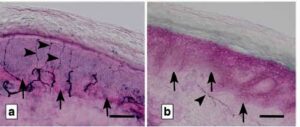Great study, disappointed I missed it when it came out. I'm utterly convinced there are vasodilation/constriction aspects to PEM and indeed have recently seen some results on midodrine, which improves vasoconstriction.
What I think this study lacks however is a bridge to the immune aspects of MECFS. I think most of us would agree that PEM feels similar in some ways to the way your immune system activates at the start of a cold, or after getting a vaccine, etc. The delay in onset is also remniscent of the way the immune system fires up with a delay after provocation.
So how can we link the pair? A humble theory:
I like to think about the role of ATP in red blood cells. Red blood cells release ATP to get blood vessels to dilate. This is a signalling mechanism that works quite simply: the red blood cells get squeezed and jostled when they go into a tube that's too narrow, they squirt out ATP which the tube receives as a signal telling it to relax and widen up. (yes, ATP the energy molecule, I think it's
highly relevant here that the energy molecule is also a vaso-dilation signalling mechanism). This is called "shear stress".
If the blood vessels don't respond, presumably they dump more ATP. Dumping ATP into the body is also
a cellular distress signal (Naviaux 2013) that could (Here I am straying into a personal theory as I've seen no papers on this) trigger a broader activation of the immune system.
Here's a paper on rbc atp release
https://www.pnas.org/content/105/43/16432
ATP is a purine. Purinergic signalling was once a major topic in this forum!
https://forums.phoenixrising.me/thr...-in-pursuit-of-a-unified-me-cfs-theory.55801/

